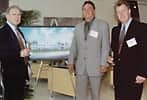To create effective policies, one must refine them by examining each process closely and carefully.

Recently, I was provided with a 360-degree feedback evaluation. As most managers and directors know, this is a necessary part of one’s leadership development within any institution, and it provides valuable areas of growth opportunity if you approach identified areas of concern with an open mind. Because I have a postgraduate degree focused on strategy and finance, I was surprised when my evaluation revealed concerns from the medical staff regarding my approach to developing processes, defined within an area of the evaluation listed as “analytical thinking.” Further investigation revealed that the medical staff was primarily concerned with the slow manner of policy implementation within the center. Unfortunately, no successful policy can be completed without scrutinizing the processes involved, and typically this is time-consuming and much more involved than it may appear at the outset.
The method in which one approaches policy creation varies depending on one’s individual training and experience. The underlying aspects of policy creation can include identification of a problem, method, or area of education; the steps to resolve the problem; and the implementation of the new processes in a successful policy. Physicians often focus on the “big picture,” wanting the completion of the policy as soon as possible to bring about a swift resolution and therefore implementation of an accurate policy. However, one must focus on the steps in each process to get to the big picture.
Typically, during the process evaluation, a manager or director will encounter what can be referred to as “bottlenecks” within the policy—key steps that require much more detailed examination and refinement in order to avoid jeopardizing the success of the policy entirely. In my personal experience, this has been an area of praise from hospital management while simultaneously an area of criticism from medical staff. “You focus on one part with too much emphasis” is an often-heard complaint. I would argue that despite the criticism, this is a necessary part of policy creation. Ignoring bottleneck steps leads to policies that will ultimately be misunderstood, ignored, or revised ad nauseam until corrected. I would propose to managers of sleep centers to ignore complaints of focusing on the details; it will save you time, energy, and potential turnover later.
Let us consider the example of a bilevel positive airway pressure (PAP) therapy policy. Most sleep centers have their own unique variant of a bilevel policy. In this case, we will assume that the policy is simply this (in most facilities it is much more detailed):
Bilevel PAP is most commonly indicated for patients with obesity-hypoventilation syndrome, chronic obstructive pulmonary disease (COPD), congestive heart failure (CHF), and a variety of neuromuscular disorders, and those that are intolerant of CPAP (continuous PAP) therapy. If you are ordered to titrate a patient on bilevel therapy, initiate the study in CPAP mode. Titrate expiratory PAP (EPAP) to equal inspiratory PAP (IPAP) until obstructive apneas are eliminated. Increase IPAP for residual snoring and obstructive hypopneas or if the patient displays evidence of upper airway resistance syndrome (UARS).
In this case technicians and technologists could potentially be placed into situations in which they are confused. When can the technician change to bilevel mode? How do you define “intolerance of CPAP”? Does the facility have specific definitions regarding UARS? How far apart should IPAP and EPAP be set during testing? Left in this state, this policy could lead to a different kind of bilevel test result every time and a complete lack of consistency within the facility.
This example is crude; however, it stresses the point I am trying to make. Only by breaking down and examining in detail each step a technician must take in order for there to be a proper bilevel titration will this policy become effective.
Examination Avoids Disaster
Let us take another example: scanning paperwork. In our facility we are paperless, so every paper document ends up getting scanned into the computer. Sounds simple enough, right? Wrong. I can assure you, despite having a crew of skilled computer-savvy employees, our team discovered that there is much more to this process than it sounds.
Initially, it was decided that our sleep center should purchase a self-feeding scanner. Paying no attention to the pages per minute scan rate, we decided to purchase a model that looked good on paper, was compatible with our computers, and was cheap enough not to raise budget concerns. The basic policy initially looked something like this:
- Open the scanning software.
- Scan the paperwork.
- Save the paperwork in the “/scans” folder.
- Attach the paperwork to the virtual chart.
Again, this appears simple at the outset. A few hours of training for the staff and voila, we would be scanning and officially paperless. Had we simply looked at the “big picture,” this would have ended up a disaster. Taking a closer look at the individual processes, we discovered that the scanning process with the scanners that we had ordered would take approximately 2 to 5 minutes to do four pages. As most people know, sleep centers generate a ton of paperwork—presleep questionnaires, postsleep questionnaires, medication lists, physician orders, technician checks, patient medical histories and physical examinations, initial intake paperwork, registration, etc. We were about to implement a policy that would require between 8 and 10 hours of scanning per day, with insufficient staff to handle the increased workload.
Another identified area of concern was that the policy was nonspecific as to what the scans should be named when saved and how the scans should be identified in the virtual chart. This would lead to mass confusion for the medical staff because different technicians and technologists would call items by different names.
Finally, there was the issue of backup and storage space to consider. Each set of scans would take up about one megabyte of space on computers that contained only 120 gigabytes of space. This would result in a lack of hard disk drive storage in less than 3 months. These potentially drastic errors were identified only by scrutinizing and analyzing each individual process that made up the policy.
Tips For Successful Policy Creation
Medical staff members want the best for their patients, and, as directors, we want the facility to run in an efficient and safe manner. This requires thorough investigation and analysis into each process of every policy created within the center. Here are some tips for policy implementation:
- Develop a team to help; include night staff in the process, or at least team leaders and/or clinical coordinators.
- Allot plenty of time to complete the policy. A rushed policy is the primary reason most people avoid or ignore individual process evaluation and jump to the end. This leads to complaints, repeated tests, and upset patients, physicians, or both.
- Run a trial of the processes, if applicable. See how they play out in the real world; paying close attention to areas of the processes that seem unclear or require assumptions by the staff.
- Be prepared to accept criticism and revisions by members of the medical staff as they are the ones ultimately responsible for patient care and may be required to sign off on the policy.
One cannot skip to the end or focus only on the final goal; every step has to be examined and thought out before it can be trusted to be an effective part of any policy. It is the refinement of each process that will refine the policy into something that is useful, complete, and permanent.
T. Massey Arrington, RPSGT, MBA, is director of sleep services for the Sleep Institute at Baptist Hospital of East Tennessee and Baptist Hospital West in Knoxville. A sleep medicine professional for more than 12 years, Arrington received his master of business administration degree from Vanderbilt University, Nashville, Tenn, in 2000.




